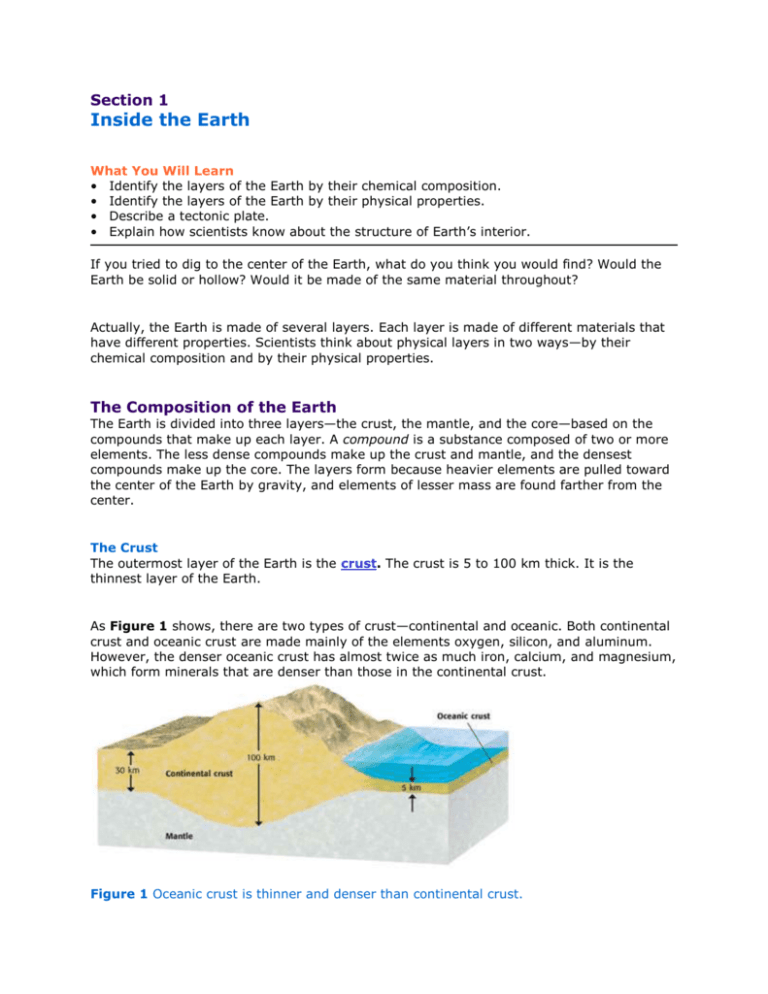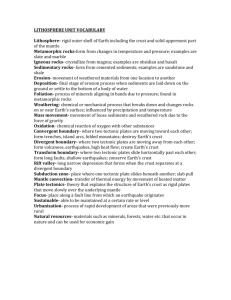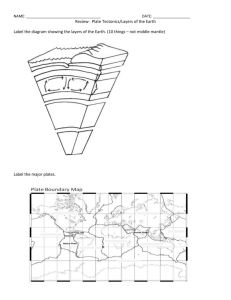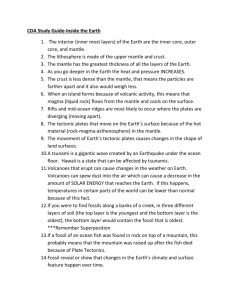inside earth text
advertisement

Section 1 Inside the Earth What You Will Learn • Identify the layers of the Earth by their chemical composition. • Identify the layers of the Earth by their physical properties. • Describe a tectonic plate. • Explain how scientists know about the structure of Earth’s interior. If you tried to dig to the center of the Earth, what do you think you would find? Would the Earth be solid or hollow? Would it be made of the same material throughout? Actually, the Earth is made of several layers. Each layer is made of different materials that have different properties. Scientists think about physical layers in two ways—by their chemical composition and by their physical properties. The Composition of the Earth The Earth is divided into three layers—the crust, the mantle, and the core—based on the compounds that make up each layer. A compound is a substance composed of two or more elements. The less dense compounds make up the crust and mantle, and the densest compounds make up the core. The layers form because heavier elements are pulled toward the center of the Earth by gravity, and elements of lesser mass are found farther from the center. The Crust The outermost layer of the Earth is the crust. The crust is 5 to 100 km thick. It is the thinnest layer of the Earth. As Figure 1 shows, there are two types of crust—continental and oceanic. Both continental crust and oceanic crust are made mainly of the elements oxygen, silicon, and aluminum. However, the denser oceanic crust has almost twice as much iron, calcium, and magnesium, which form minerals that are denser than those in the continental crust. Figure 1 Oceanic crust is thinner and denser than continental crust. The Mantle The layer of the Earth between the crust and the core is the mantle.The mantle is much thicker than the crust and contains most of the Earth’s mass. No one has ever visited the mantle. The crust is too thick to drill through to reach the mantle. Scientists must draw conclusions about the composition and other physical properties of the mantle from observations made on the Earth’s surface. In some places, mantle rock pushes to the surface, which allows scientists to study the rock directly. As you can see in Figure 2, another place scientists look for clues about the mantle is the ocean floor. Magma from the mantle flows out of active volcanoes on the ocean floor. These underwater volcanoes have given scientists many clues about the composition of the mantle. Because the mantle has more magnesium and less aluminum and silicon than the crust does, the mantle is denser than the crust. Figure 2 Volcanic vents on the ocean floor, such as this vent off the coast of Hawaii, allow magma to rise up through the crust from the mantle. The Core The layer of the Earth that extends from below the mantle to the center of the Earth is the core. Scientists think that the Earth’s core is made mostly of iron and contains smaller amounts of nickel but almost no oxygen, silicon, aluminum, or magnesium. As shown in Figure 3, the core makes up roughly one-third of the Earth’s mass. Figure 3 The Earth is made up of three layers based on the composition of each layer. Briefly describe the layers that make up the Earth. The Physical Structure of the Earth Another way to look at the Earth is to examine the physical properties of its layers. The Earth is divided into five physical layers—the lithosphere, asthenosphere, mesosphere, outer core, and inner core. As shown in the figure below, each layer has its own set of physical properties. What are the five physical layers of the Earth? Tectonic Plates Pieces of the lithosphere that move around on top of the asthenosphere are called tectonic plates. But what exactly does a tectonic plate look like? How big are tectonic plates? How and why do they move around? To answer these questions, begin by thinking of the lithosphere as a giant jigsaw puzzle. A Giant Jigsaw Puzzle All of the tectonic plates have names, some of which you may already know. Some of the major tectonic plates are named on the map in Figure 4. Notice that each tectonic plate fits together with the tectonic plates that surround it. The lithosphere is like a jigsaw puzzle, and the tectonic plates are like the pieces of a jigsaw puzzle. Figure 4 Tectonic plates fit together like the pieces of a giant jigsaw puzzle. Notice that not all tectonic plates are the same. For example, compare the size of the South American plate with that of the Cocos plate. Tectonic plates differ in other ways, too. For example, the South American plate has an entire continent on it and has oceanic crust, but the Cocos plate has only oceanic crust. Some tectonic plates, such as the South American plate, include both continental and oceanic crust. A Tectonic Plate Close-Up What would a tectonic plate look like if you could lift it out of its place?Figure 5 shows what the South American plate might look like if you could. Notice that this tectonic plate not only consists of the upper part of the mantle but also consists of both oceanic crust and continental crust. The thickest part of the South American plate is the continental crust. The thinnest part of this plate is in the mid-Atlantic Ocean. Figure 5 The South American Plate Like Ice Cubes in a Bowl of Punch Think about ice cubes floating in a bowl of punch. If there are enough cubes, they will cover the surface of the punch and bump into one another. Parts of the ice cubes are below the surface of the punch and displace the punch. Large pieces of ice displace more punch than small pieces of ice. Tectonic plates “float” on the asthenosphere in a similar way. The plates cover the surface of the asthenosphere, and they touch one another and move around. The lithosphere displaces the asthenosphere. Thick tectonic plates, such as those made of continental crust, displace more asthenosphere than do thin plates, such as those made of oceanic lithosphere. Why do tectonic plates made of continental lithosphere displace more asthenosphere than tectonic plates made of oceanic lithosphere do? Mapping the Earth’s Interior How do scientists know things about the deepest parts of the Earth, where no one has ever been? Scientists have never even drilled through the crust, which is only a thin skin on the surface of the Earth. So, how do we know so much about the mantle and the core? Would you be surprised to know that some of the answers come from earthquakes? When an earthquake happens, vibrations called seismic waves are produced. Seismic waves travel at different speeds through the Earth. Their speed depends on the density and composition of material that they pass through. For example, a seismic wave traveling through a solid will go faster than a seismic wave traveling through a liquid. When an earthquake happens, machines called seismographs measure the times at which seismic waves arrive at different distances from an earthquake. Seismologists can then use these distances and travel times to calculate the density and thickness of each physical layer of the Earth. Figure 6 shows how seismic waves travel through the Earth. Figure 6 By measuring changes in the speed of seismic waves that travel through Earth’s interior, seismologists have learned that the Earth is made of different layers. What are some properties of seismic waves? Section Summary • The Earth is made up of three layers—the crust, the mantle, and the core—based on chemical composition. Less dense compounds make up the crust and mantle. Denser compounds make up the core. • The Earth is made up of five main physical layers: the lithosphere, the asthenosphere, the mesosphere, the outer core, and the inner core. • Tectonic plates are large pieces of the lithosphere that move around on the Earth’s surface. • The crust in some tectonic plates is mainly continental. Other plates have only oceanic crust. Still other plates include both continental and oceanic crust. • Thick tectonic plates, such as those in which the crust is mainly continental, displace more asthenosphere than do thin plates, such as those in which the crust is mainly oceanic. • Knowledge about the layers of the Earth comes from the study of seismic waves caused by earthquakes.







